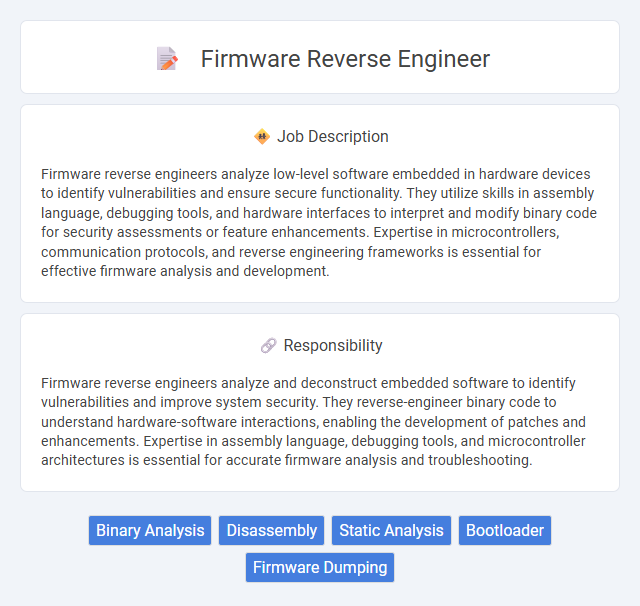
Firmware reverse engineers analyze low-level software embedded in hardware devices to identify vulnerabilities and ensure secure functionality. They utilize skills in assembly language, debugging tools, and hardware interfaces to interpret and modify binary code for security assessments or feature enhancements. Expertise in microcontrollers, communication protocols, and reverse engineering frameworks is essential for effective firmware analysis and development.
Individuals with strong analytical skills and patience might find firmware reverse engineering suitable, given the complexity and detail-oriented nature of the work. Those who enjoy problem-solving and possess a solid understanding of hardware-software interaction could have a higher likelihood of success in this role. Candidates lacking perseverance or a technical background may find this job challenging and less compatible with their strengths.
Qualification
A Firmware Reverse Engineer requires deep expertise in embedded systems, proficiency in low-level programming languages such as C and assembly, and strong skills in reverse engineering tools like IDA Pro and Ghidra. Candidates must have a solid understanding of hardware architecture, communication protocols, and firmware debugging techniques. Experience with real-time operating systems (RTOS) and knowledge of cybersecurity principles are crucial for analyzing and securing firmware code effectively.
Responsibility
Firmware reverse engineers analyze and deconstruct embedded software to identify vulnerabilities and improve system security. They reverse-engineer binary code to understand hardware-software interactions, enabling the development of patches and enhancements. Expertise in assembly language, debugging tools, and microcontroller architectures is essential for accurate firmware analysis and troubleshooting.
Benefit
Firmware reverse engineer roles likely offer the benefit of enhancing technical expertise in embedded systems and low-level programming. Professionals in this area probably gain valuable experience in cybersecurity, which can increase job security and marketability. This position may also provide opportunities for problem-solving in complex hardware-software interactions, potentially leading to career growth in high-demand tech sectors.
Challenge
Firmware reverse engineering likely involves complex challenges due to the need for deep understanding of low-level hardware interactions and proprietary code structures. The task often requires deciphering undocumented firmware, which increases the probability of encountering hidden security vulnerabilities or intricate encryption methods. Mastery in this field probably demands continuous learning and adaptability to evolving embedded system technologies.
Career Advancement
Firmware reverse engineers leverage expertise in embedded systems and low-level programming to analyze and improve device functionality, enhancing cybersecurity and product performance. Career advancement often leads to roles such as lead reverse engineer, security analyst, or embedded systems architect, with opportunities to specialize in areas like IoT security or automotive firmware. Continuous skill development in assembly languages, debugging tools, and cryptographic protocols is essential for progressing to senior technical or managerial positions.
Key Terms
Binary Analysis
Firmware reverse engineers specializing in binary analysis utilize advanced disassembly and debugging tools to dissect and understand compiled code within embedded systems. They identify vulnerabilities, malware, or hidden functionalities by examining low-level machine instructions and memory structures. Proficiency in assembly languages, hex editors, and reverse engineering frameworks like IDA Pro or Ghidra is essential for this role.
Disassembly
Firmware reverse engineers specialize in disassembly to analyze low-level code embedded in hardware devices, enabling the identification of vulnerabilities and unauthorized modifications. Using tools like IDA Pro, Ghidra, and Radare2, they convert binary firmware files into human-readable assembly language for detailed examination. This skill is crucial for security auditing, malware analysis, and enhancing device interoperability.
Static Analysis
Firmware reverse engineers specializing in static analysis meticulously examine binary code without executing it to uncover vulnerabilities, decode proprietary protocols, and understand firmware behavior. They utilize advanced tools such as IDA Pro, Ghidra, and Radare2 to dissect machine code and identify security flaws embedded within embedded systems. Expertise in ARM, MIPS, and x86 architectures enhances the precision of static code parsing and vulnerability assessment in IoT devices and cybersecurity contexts.
Bootloader
Firmware reverse engineers specializing in bootloaders analyze and modify the initial code that runs during hardware startup to ensure secure and efficient system initialization. They utilize low-level debugging tools and disassemblers to identify vulnerabilities, optimize boot sequences, and enable firmware updates or custom modifications. Their expertise is crucial for preventing unauthorized access and enhancing device reliability in embedded systems.
Firmware Dumping
Firmware reverse engineers specialize in extracting and analyzing firmware code through firmware dumping techniques, crucial for understanding device functionality and security vulnerabilities. Firmware dumping involves obtaining a binary image from embedded devices using hardware interfaces like JTAG, SPI, or UART to enable detailed inspection and modification. Mastery of hardware protocols, memory mapping, and debugging tools is essential to successfully retrieve and manipulate firmware for reverse engineering purposes.
 kuljobs.com
kuljobs.com